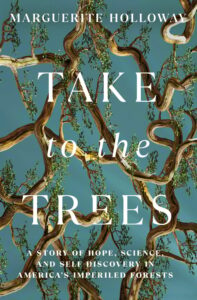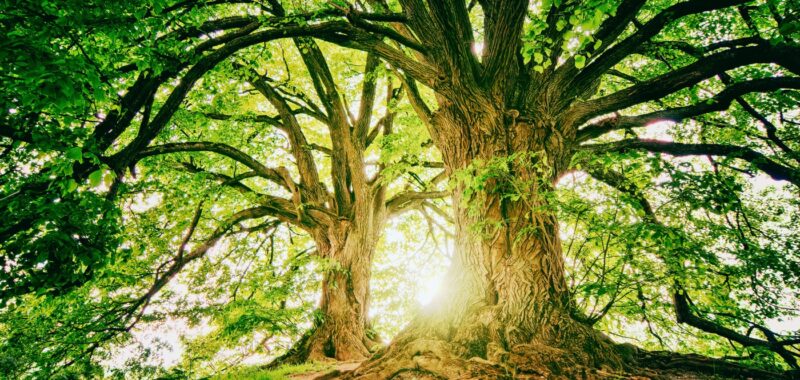Three hemlocks stand close in the small grove. They have grown up together, about twenty feet apart, their branches touching in places, their life histories intertwined. They have been through the same storms, felt the same winds, the same heat, and the same winters. They have shared creatures. Squirrels, chipmunks, warblers, flycatchers, thrushes, spiders, and dozens of other animals have moved between them. Deer, skunk, turkey, porcupine, bobcat, fisher, hare, bear, and perhaps a moose or few have moved beneath them. Hemlocks are among the longest-lived trees on the East Coast and in the right conditions—in cool damp, absent certain pests—these conifers can live at least five hundred years and reach over one hundred feet.
Article continues after advertisement
These three are about seventy years old and eighty feet tall. Even young hemlocks have gravitas. They are stunning dark trees, their bark deeply creviced and thick. Some hemlocks have bottom branches that droop toward the ground at the tips, creating around the trunk a circular open-air room with a low roof. These three have no lower branches that are easy to grab hold of. Their green-needled limbs start fifteen feet up.
I came to know trees more deeply. I began to look closely, to see and to understand our profound connection to them.
Fifteen feet can be fifteen feet too high when you are learning to climb trees, as I set out to do one May weekend at Camp Hi-Rock in Mount Washington, Massachusetts. The sign for the YMCA camp is tucked back from a main road and although I had spotted a fox loping through underbrush, I missed the turnoff. A hiker who had been looking for birds and butterflies on the nearby Alander Mountain Trail—“lots of warblers, including a black-throated green…not many fritillaries, but a lot of swallowtails at lower elevations”—gave directions and said that the road to the camp was long and I might think it was never going to end. Somewhere along that pitted dusty road, cell service fell away. The cluster of cabins that finally appeared felt remote and the woods a bit wild.
Two dozen women and I had come to participate in the Women’s Tree Climbing Workshop, an organization founded by identical twin sister arborists Bear LeVangie and Melissa LeVangie Ingersoll. The workshop has trained over two thousand women, mostly those who care for trees professionally, but also lichenologists, ornithologists, primatologists, other ologists, circus performers, dancers, artists, photographers, writers, and the generally arboreally curious. That weekend, some of the women were office-based or ground-crew arborists who wanted to learn to climb. Some were arborists who wanted to improve their skills or get back in trees after a hiatus or injury. Some wanted to have an adventure and to escape pandemic isolation. Some wanted just to spend time in trees.
I was there to be in trees and to better understand them. Trees and forests are facing existential threats because of climate change, but it can be a struggle to grasp the extent of the danger or to make sense of the complex and deadly interactions playing out between heat, drought, fire, water, disease, and pests. I hoped that being in trees would allow me to better see them through the eyes of people, like the LeVangies, who care for trees and who perceive so much more about trees and forests than many of us do.
I also wanted to overcome, if possible, a terror of heights that had developed after I became a mother. If either of my kids or anyone I was with moved toward the edge of something, my shins felt squeamish and fuzzy, coursed by waves of electric buzzing. The fear traveled from my legs and sometimes from the back of my hands to my core, becoming a gut-lurching sense of being on a precipice that I am going to fall off and yet can’t step back from. Dizzying and destabilizing, it is a feeling not unlike the one I have when thinking about climate change.
That spring weekend at Hi-Rock turned out to be the start of an ascent in ways I did not anticipate. As I came to understand more fully what climate change is doing to trees and forests, I began to climb regularly, returning to the workshop several times as a participant and traveling around the country to observe others. I met women of all ages—from those in their twenties to those in their seventies—and of all backgrounds. Over and over, I heard stories of sexism, many set in the predominantly male arboriculture industry. But the stories could be set most anywhere. They are experiences familiar to many women, to many people: stories of disregard, indifference, othering, dehumanization, hierarchy, and subjugation. They are the origin stories of the climate crisis: centuries of exploitation of people and the nonhuman natural world.
If trees are to continue to sustain us and to help us address our apocalyptic mess, we need to pay them more attention.
Over and over, I observed and spoke with people transformed by the Women’s Tree Climbing Workshop. The LeVangies and the other instructors—many of them tree-climbing champions who excel in a dangerous, difficult profession and who are working to transform it—create community that is respectful and, frequently, hilarious. They express confidence in everyone’s ability to do seemingly impossible new things. Participants learn technical skills while routinely discovering physical, mental, and emotional strength they didn’t know they had, or that they had lost touch with. Climbing made them feel more confident, more powerful, more hopeful, and part of an ever-expanding community—“a mycelial network,” the LeVangies say.
Many have gone on to change their work culture or to change their jobs, their lives, their relationships. For many, climbing also rekindled a connection to the natural world. “It reconnected me with nature in a way that I haven’t really felt since I was a kid,” says Sian Bareket, who took the workshop when she was a college sophomore. “They really highlighted that you’re not just climbing a tree, you are entering an ecosystem and you are being held up by a living organism.”
Climbing in the way that the LeVangies and team teach it—engendering a culture of consideration, attention, and care—can change people in surprising ways. You think you are learning one set of things, but discover you are learning a whole different set. As I learned to climb, I did things I never thought I could do. I overcame physical weakness and phobias. I came to rely on other people and trust myself in new ways. I came to terms with tragedy and loss in my family. I found a new way to confront climate anxiety. And I came to know trees more deeply. I began to look closely, to see and to understand our profound connection to them.
Everything that flows from trees and forests—clean air, biodiversity, cooler temperatures, clean water, human health, carbon kept solid and out of atmospheric currency, rain, regional weather patterns, culture, history—is unraveling. If trees are to continue to sustain us and to help us address our apocalyptic mess, we need to pay them more attention, give them more care. We need to take to the trees.
__________________________________

From Take to the Trees: A Story of Hope, Science, and Self-Discovery in America’s Imperiled Forests by Marguerite Holloway. Copyright © 2025 by Marguerite Holloway. Used with permission of the publisher, W. W. Norton & Company, Inc. All rights reserved.

